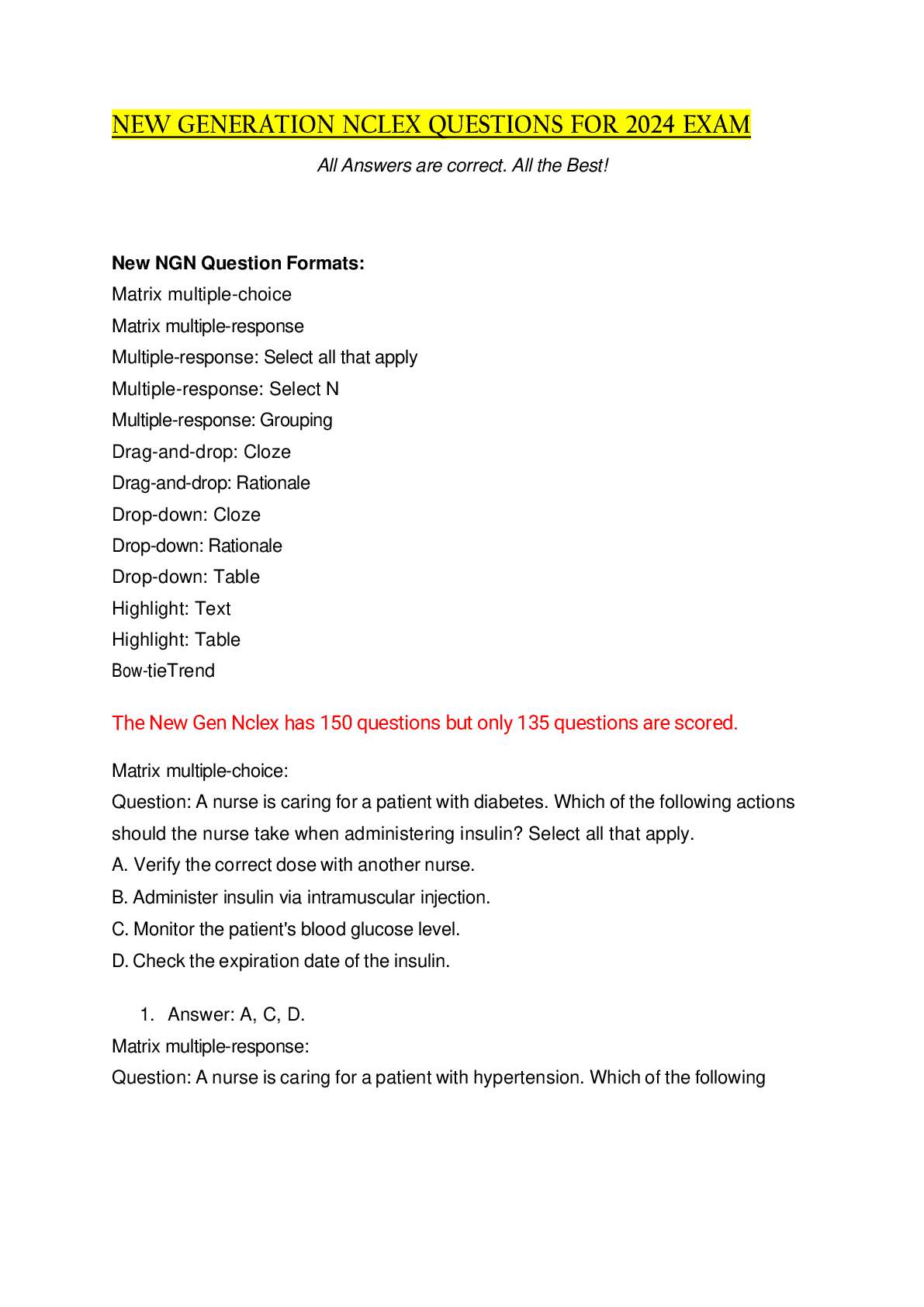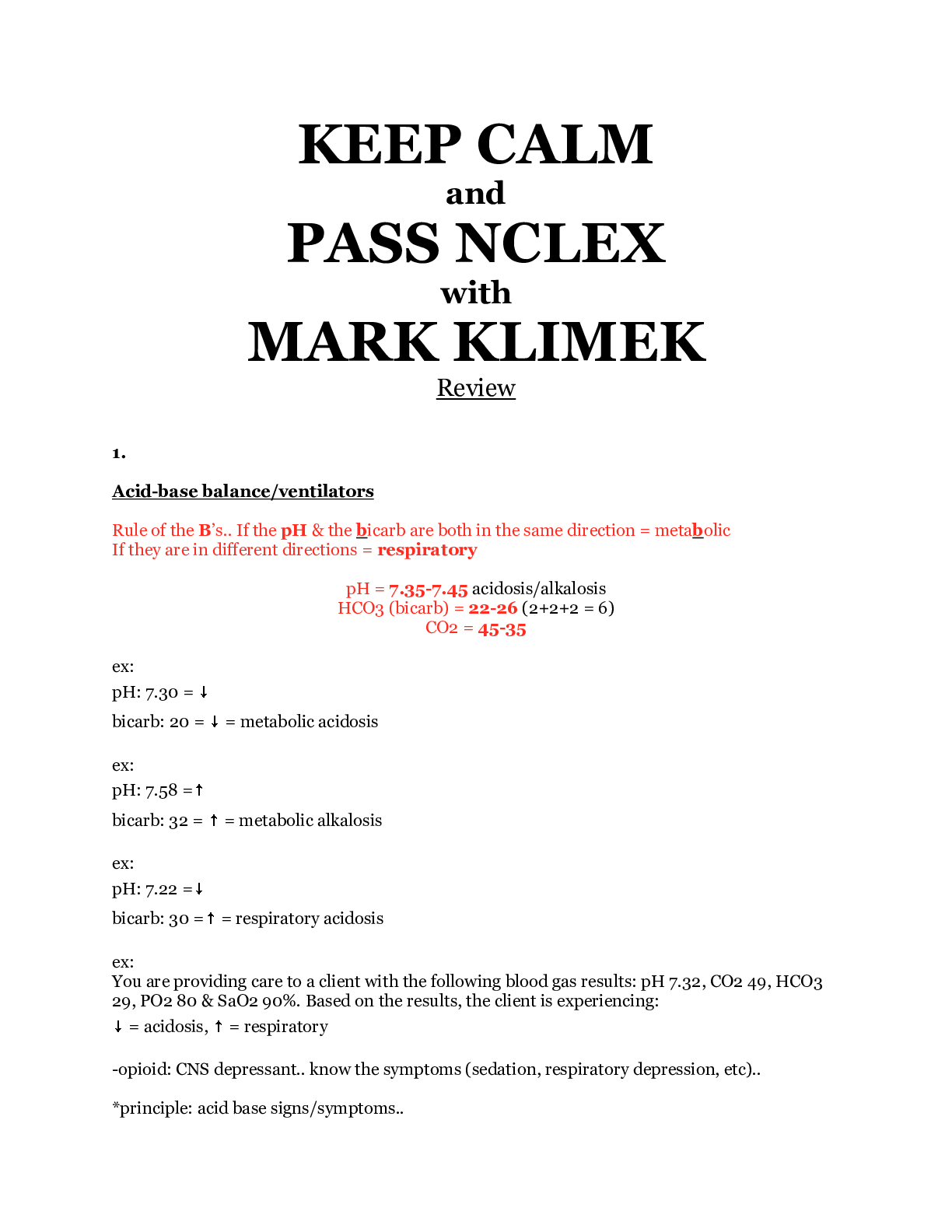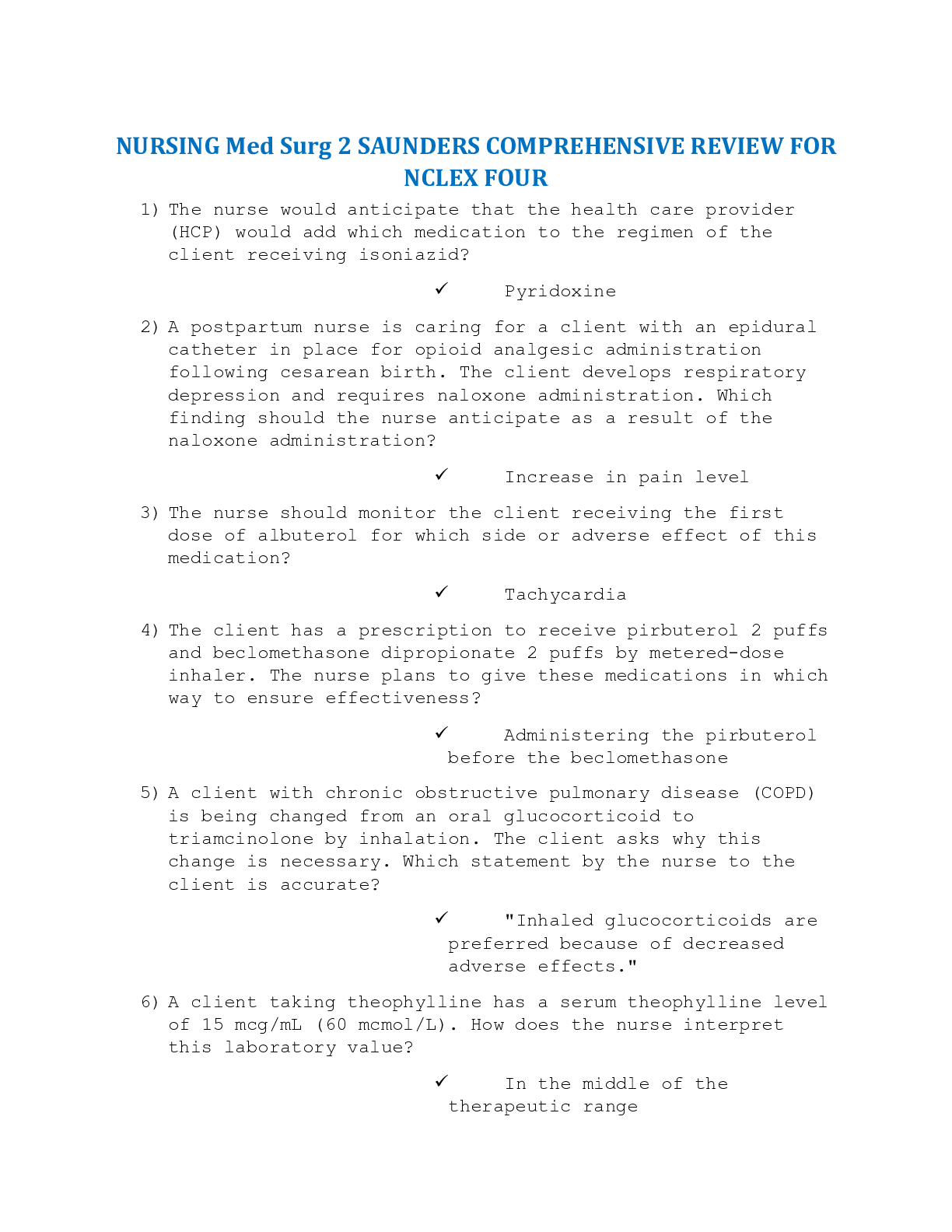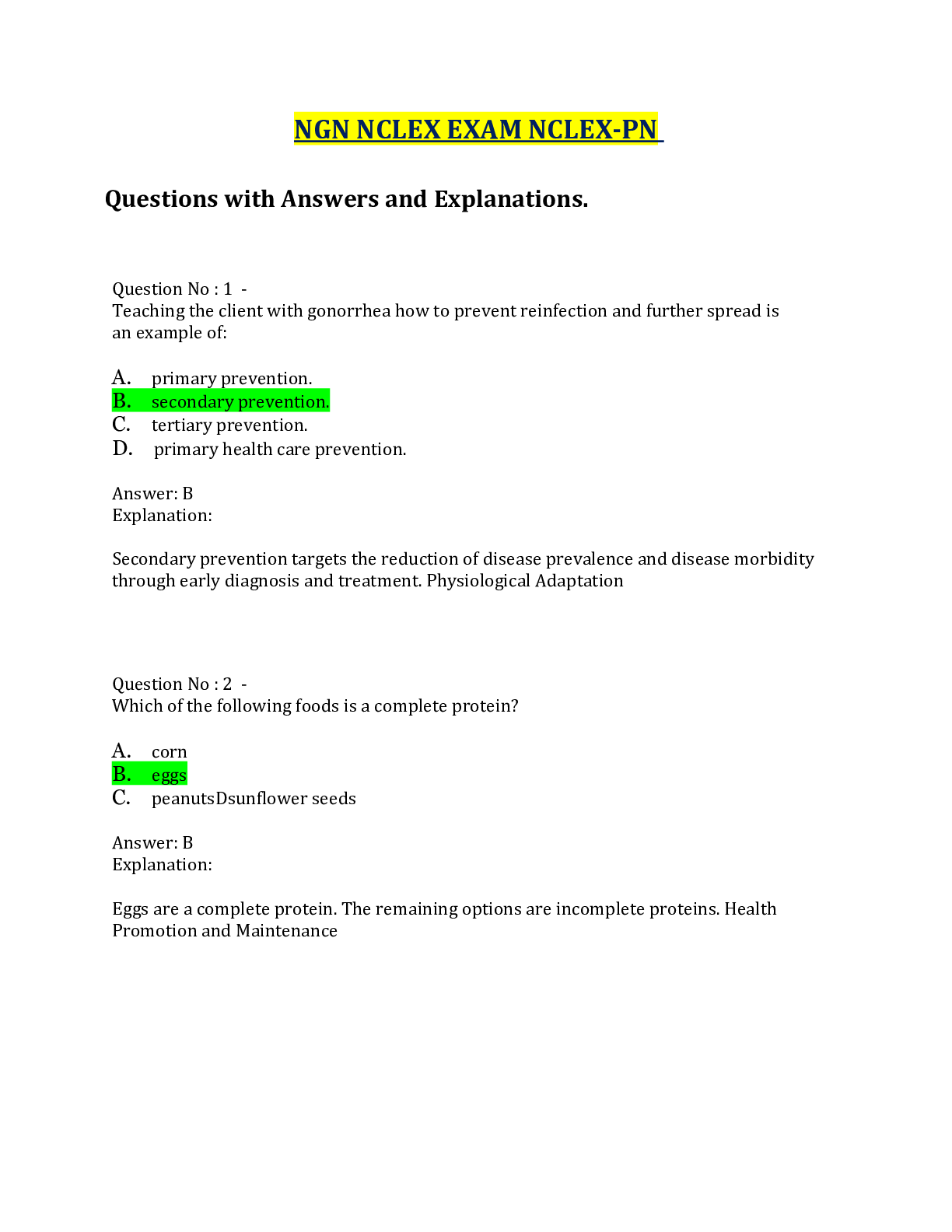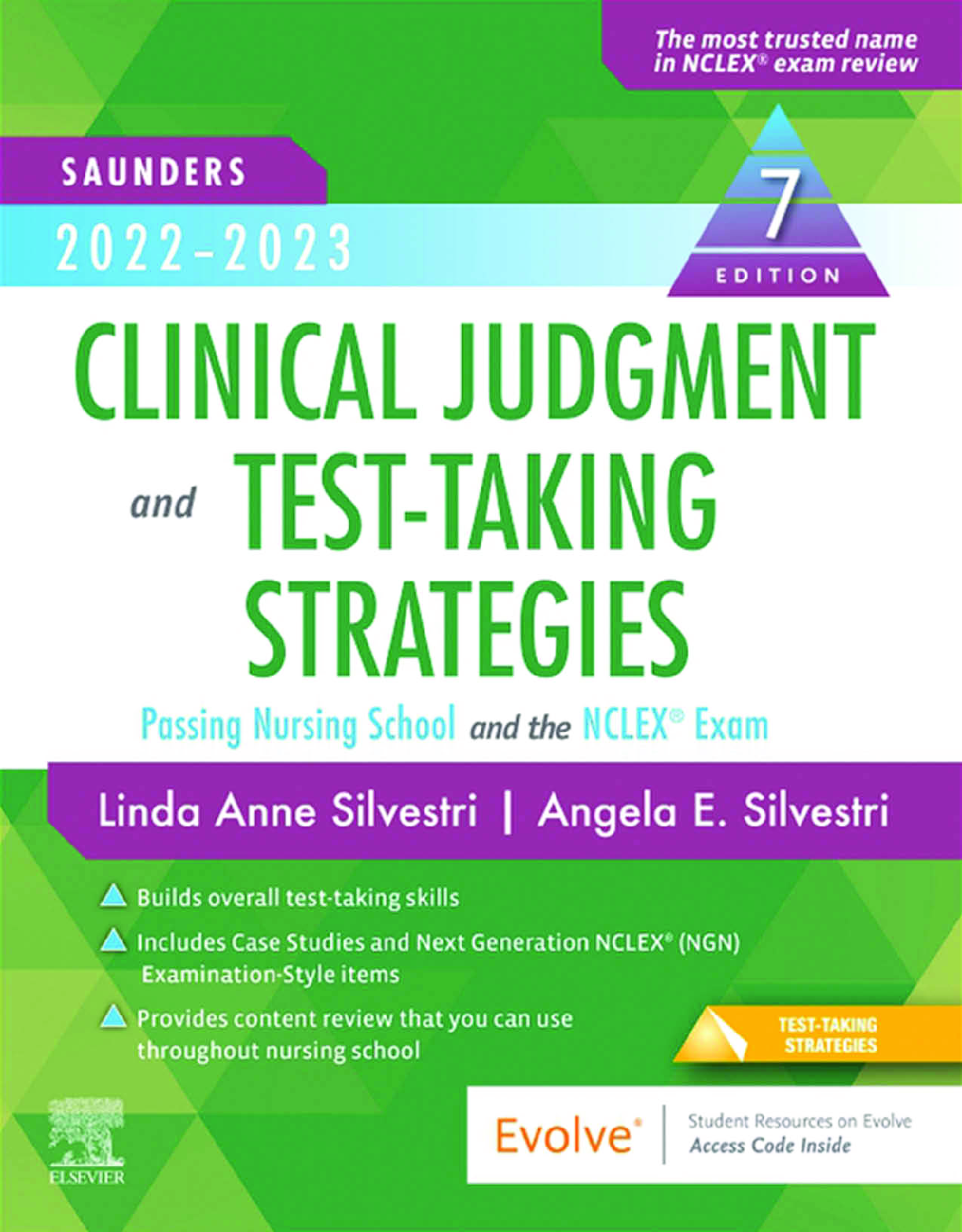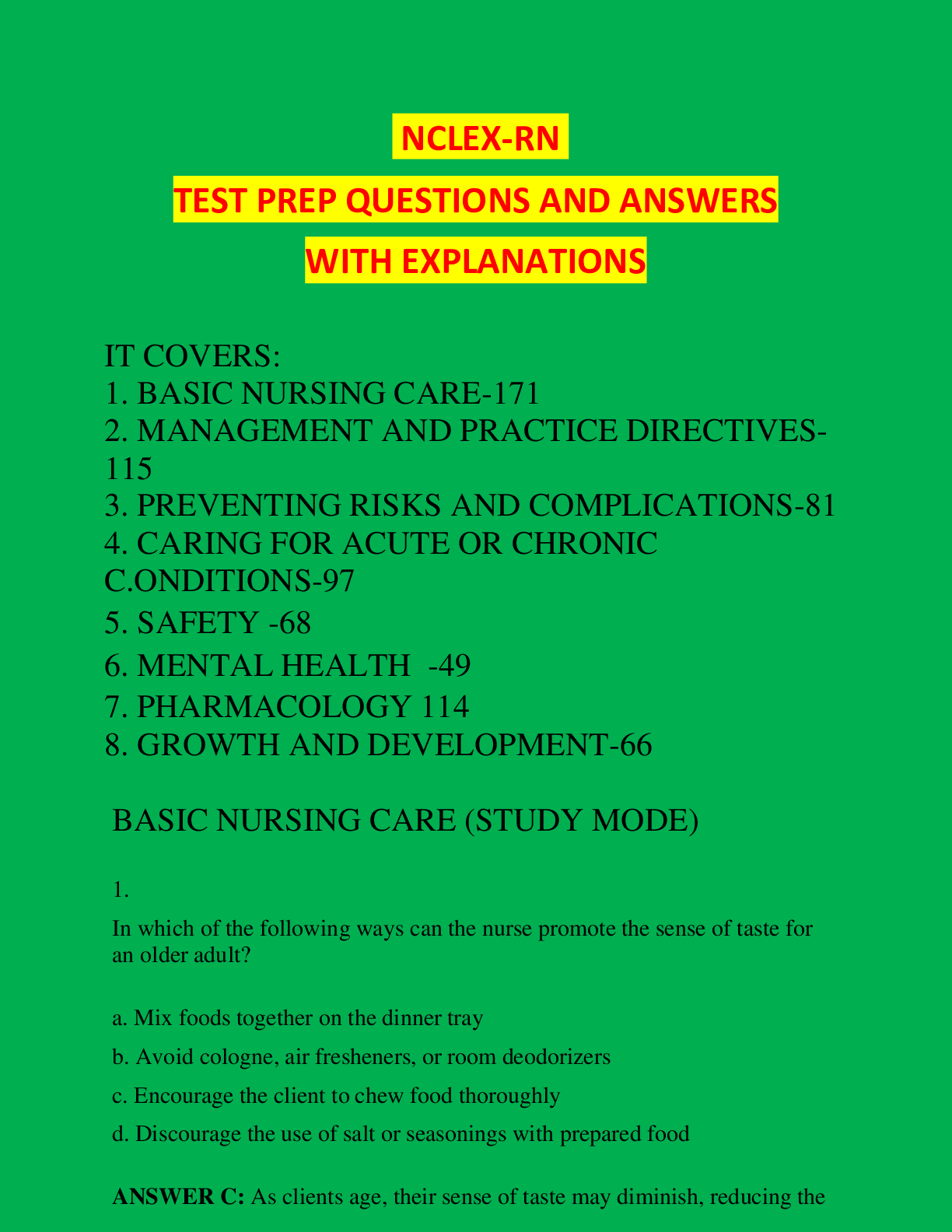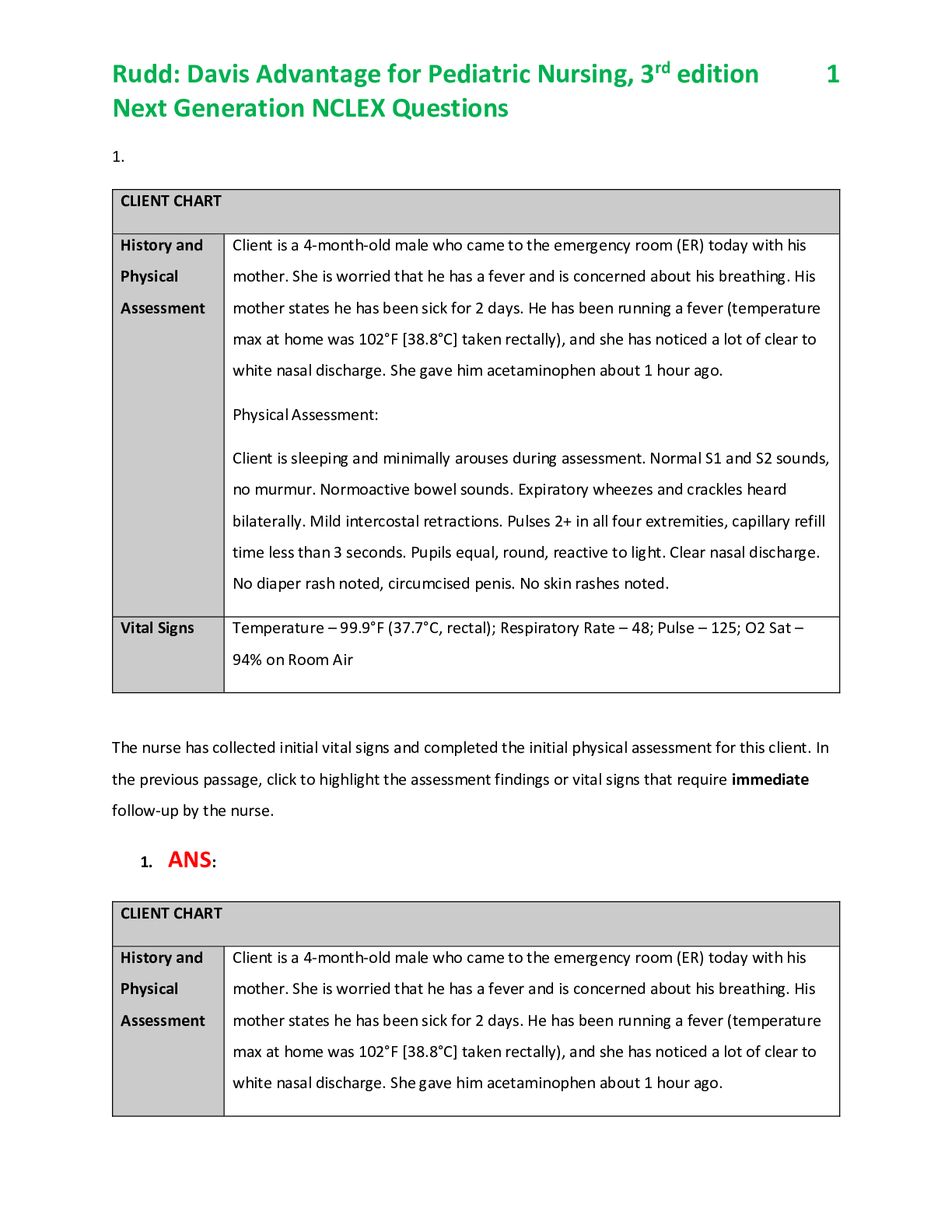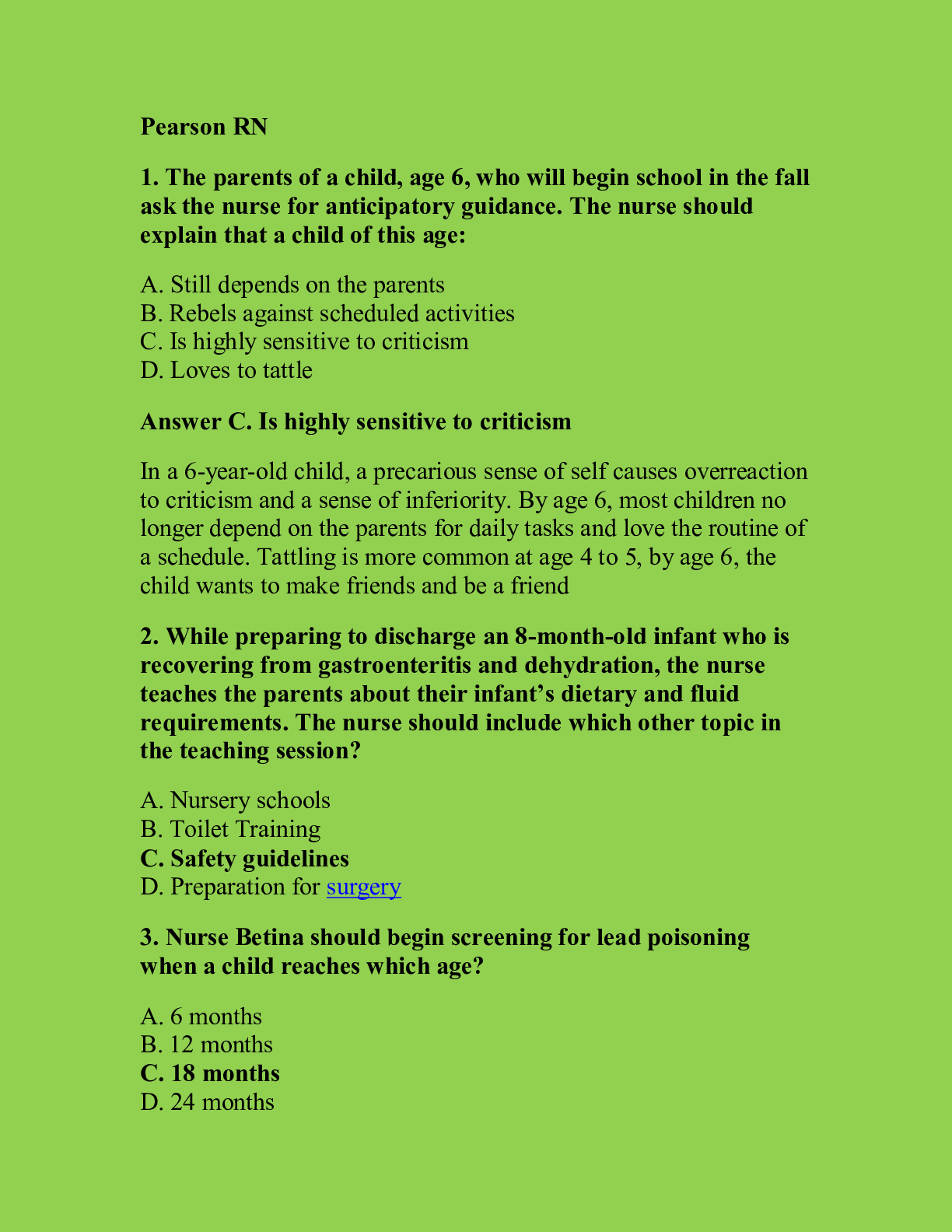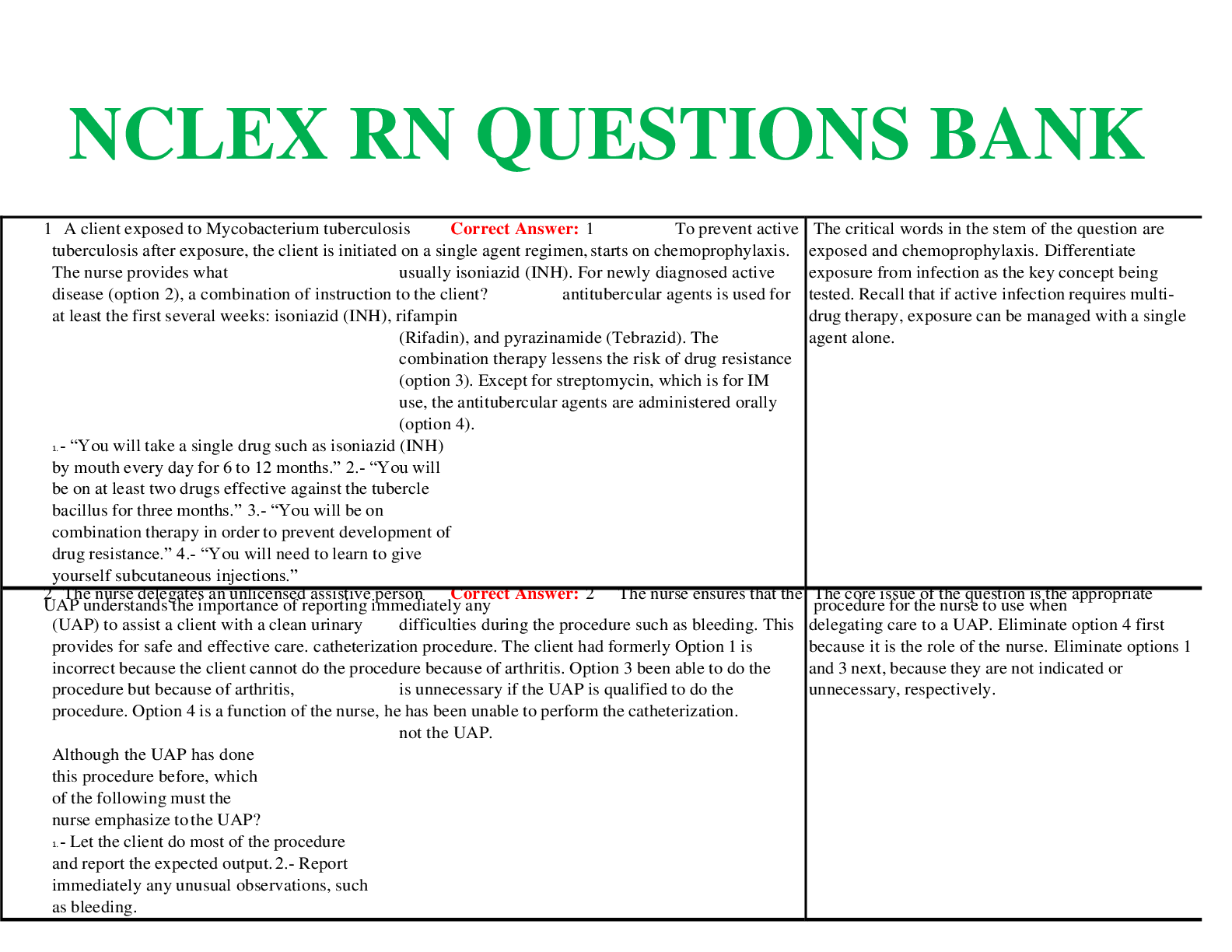*NURSING > NCLEX > NCLEX-RN Title : National Council Licensure Examination(NCLEX-RN) 2022 with detailed answer key (All)
NCLEX-RN Title : National Council Licensure Examination(NCLEX-RN) 2022 with detailed answer key
Document Content and Description Below
NO.24 One of the most reliable assessment tools for adequacy of fluid resuscitation in burned children is: A. Blood pressure B. Level of consciousness C. Skin turgor D. Fluid intake Answer: B E... xplanation: (A) Blood pressure can remain normotensive in a state of hypovolemia. (B) Capillary refill, alterations in sensorium, and urine output are the most reliable indicators for assessing hydration. (C) Skin turgor is not a reliable indicator for assessing hydration in a burn client. (D) Fluid intake does not indicate adequacy of fluid resuscitation in a burn client. NO.25 Which one of the following is considered a reliable indicator for assessing the adequacy of fluid resuscitation in a 3-year-old child who suffered partial- and fullthickness burns to 25% of her body? A. Urine output B. Edema C. Hypertension D. Bulging fontanelle IT Certification Guaranteed, The Easy Way! 10 Answer: A Explanation: (A) Urinary output is a reliable indicator of renal perfusion, which in turn indicates that fluid resuscitation is adequate. IV fluids are adjusted based on the urinary output of the child during fluid resuscitation. (B) Edema is an indication of increased capillary permeability following a burn injury. (C) Hypertension is an indicator of fluid volume excess. (D) Fontanelles close by 18 months of age. NO.26 A client with a diagnosis of C-4 injury has been stabilized and is ready for discharge. Because this client is at risk for autonomic dysreflexia, he and his family should be instructed to assess for and report: A. Dizziness and tachypnea B. Circumoral pallor and lightheadedness C. Headache and facial flushing D. Pallor and itching of the face and neck Answer: C Explanation: (A) Tachypnea is not a symptom. (B) Circumoral pallor is not a symptom. (C) Autonomic dysreflexia is an uninhibited and exaggerated reflex of the autonomic nervous system to stimulation, which results in vasoconstriction and elevated blood pressure. (D) Pallor and itching are not symptoms. NO.27 A client states to his nurse that "I was told by the doctor not to take one of my drugs because it seems to have caused decreasing blood cells." Based on this information, which drug might the nurse expect to be discontinued? A. Prednisone B. Timolol maleate (Blocadren) C. Garamycin (Gentamicin) D. Phenytoin (Dilantin) Answer: D Explanation: (A) Prednisone is not linked with hematological side effects. (B) Timolol, a -adrenergic blocker is metabolized by the liver. It has not been linked to blood dyscrasia. (C) Gentamicin is ototoxic and nephrotoxic. (D) Phenytoin usage has been linked to blood dyscrasias such as aplastic anemia. The drug most commonly linked to aplastic anemia is chloramphenicol (Chlormycetin). NO.28 A client has been taking lithium 300 mg po bid for the past two weeks. This morning her lithium level was 1 mEq/L. The nurse should: A. Notify the physician immediately B. Hold the morning lithium dose and continue to observe the client C. Administer the morning lithium dose as scheduled D. Obtain an order for benztropine (Cogentin) Answer: C Explanation: (A) There is no need to phone the physician because the lithium level is within therapeutic range and IT Certification Guaranteed, The Easy Way! 11 because there are no indications of toxicity present. (B) There is no reason to withhold the lithium because the blood level is within therapeutic range. Also, it is necessary to give the medication as scheduled to maintain adequate blood levels. (C) The lab results indicate that the client's lithium level is within therapeutic range (0.2-1.4 mEq/L), so the medication should be given as ordered. (D) Benztropine is an antiparkinsonism drug frequently given to counteractextrapyramidal symptoms associated with the administration of antipsychotic drugs (not lithium). NO.29 The primary focus of nursing interventions for the child experiencing sickle cell crisis is aimed toward: A. Maintaining an adequate level of hydration B. Providing pain relief C. Preventing infection D. O2 therapy Answer: A Explanation: (A) Maintaining the hydration level is the focus for nursing intervention because dehydration enhances the sickling process. Both oral and parenteral fluids are used. (B) The pain is a result of the sickling process. Analgesics or narcotics will be used for symptom relief, but the underlying cause of the pain will be resolved with hydration. (C) Serious bacterial infections may result owing to splenic dysfunction. This is true at all times, not just during the acute period of a crisis. (D) O2 therapy is used for symptomatic relief of the hypoxia resulting from the sickling process. Hydration is the primary intervention to alleviate the dehydration that enhances the sickling process. NO.30 Three weeks following discharge, a male client is readmitted to the psychiatric unit for depression. His wife stated that he had threatened to kill himself with a handgun. As the nurse admits him to the unit, he says, "I wish I were dead because I am worthless to everyone; I guess I am just no good." Which response by the nurse is most appropriate at this time? A. "I don't think you are worthless. I'm glad to see you, and we will help you." B. "Don't you think this is a sign of your illness?" C. "I know with your wife and new baby that you do have a lot to live for." D. "You've been feeling sad and alone for some time now?" Answer: D Explanation: (A) This response does not acknowledge the client's feelings. (B) This is a closed question and does not encourage communication. (C) This response negates the client's feelings and does not require a response from the client. (D) This acknowledges the client's implied thoughts and feelings and encourages a response. NO.31 A 52-year-old client is scheduled for a small-bowel resection in the morning. In conjunction with other preoperative preparation, the nurse is teaching her diaphragmatic breathing exercises. IT Certification Guaranteed, The Easy Way! 12 She will teach the client to: A. Inhale slowly and deeply through the nose until the lungs are fully expanded, hold the breath a couple of seconds, and then exhale slowly through the mouth. Repeat 2-3 more times to complete the series every 1-2 hours while awake B. Purse the lips and take quick, short breaths approximately 18-20 times/min C. Take a large gulp of air into the mouth, hold it for 10-15 seconds, and then expel it through the nose. Repeat 4-5 times to complete the series D. Inhale as deeply as possible and then immediately exhale as deeply as possible at a rate of approximately 20-24 times/min Answer: A Explanation: (A) This is the correct method of teaching diaphragmatic breathing, which allows full lung expansion to increase oxygenation, prevent atelectasis, and move secretions up and out of the lungs to decrease risk of pneumonia. (B) Quick, short breaths do not allow for full lung expansion and movement of secretions up and out of the lungs. Quick, short breaths may lead to O2 depletion, hyperventilation, and hypoxia. (C) Expelling breaths through the nose does not allow for full lung expansion and the use of diaphragmatic muscles to assist in moving secretions up and out of the lungs. (D) Inhaling and exhaling at a rate of 20-24 times/min does not allow time for full lung expansion to increase oxygenation. This would most likely lead to O2 depletion and hypoxia. NO.32 The nurse enters the playroom and finds an 8-year-old child having a grand mal seizure. Which one of the following actions should the nurse take? A. Place a tongue blade in the child's mouth. B. Restrain the child so he will not injure himself. C. Go to the nurses station and call the physician. D. Move furniture out of the way and place a blanket under his head. Answer: D Explanation: (A) The nurse should not put anything in the child's mouth during a seizure; this action could obstruct the airway. (B) Restraining the child's movements could cause constrictive injury. (C) Staying with the child during a seizure provides protection and allows the nurse to observe the seizure activity. (D) The nurse should provide safety for the child by moving objects and protecting the head. NO.33 An 11-year-old boy has received a partial-thickness burn to both legs. He presents to the emergency room approximately 15 minutes after the accident in excruciating pain with charred clothing to both legs. What is the first nursing action? A. Apply ice packs to both legs. B. Begin debridement by removing all charred clothing from wound. C. Apply Silvadene cream (silver sulfadiazine). D. Immerse both legs in cool water. Answer: D Explanation: IT Certification Guaranteed, The Easy Way! 13 (A) Ice creates a dramatic temperature change in the tissue, which can cause further thermal injury. (B) Charred clothing should not be removed from wound first. This creates further tissue damage. Debridement is not the first nursing action. (C) Applying silver sulfadiazine cream first insulates heat in injured tissue and increases potential for infection. (D) Emergency care of a thermal burn is immersing both legs in cool water. Cool water permits gradual temperature change and prevents further thermal damage. NO.34 The nurse notes scattered crackles in both lungs and 1+ pitting edema when assessing a cardiac client. The physician is notified and orders furosemide (Lasix) 80 mg IV push stat. Which of the following diagnostic studies is monitored to assess for a major complication of this therapy? A. Serum electrolytes B. Arterial blood gases C. Complete blood count D. 12-Lead ECG Answer: A Explanation: (A) Furosemide, a potassium-depleting diuretic, inhibits the reabsorption of sodium and chloride from the loop of Henle and the distal renal tubules. Serum electrolytes are monitored for hypokalemia. (B) Severe acid-base imbalances influence the movement of potassium into and out of the cells, but arterial blood gases to not measure the serum potassium level. (C) Furosemide is a potassium-depleting diuretic. A complete blood count does not reflect potassium levels. (D) Abnormalities in potassium (both hyperkalemia and hypokalemia) are reflected in ECG changes, but these changes do not occur until the abnormality is severe. NO.35 A psychiatric client has been stabilized and is to be discharged. The nurse will recognize client insight and behavioral change by which of the following client statements? A. "When I get home, I will need to take my medicines and call my therapist if I have any side effects or begin to hear voices." B. "If I have any side effects from my medicines, I will take an extra dose of Cogentin." C. "When I get home, I should be able to taper myself off the Haldol because the voices are gone now." D. "As soon as I leave here, I'm throwing away my medicines. I never thought I needed them anyway." Answer: A Explanation: (A) The client verbalizes that he is responsible for compliance and keeping the treatment team member informed of progress. This behavior puts him at the lowest risk for relapse. (B) Noncompliance is a major cause of relapse. This statement reflects lack of responsibility for his own IT Certification Guaranteed, The Easy Way! 14 health maintenance. (C) This statement reflects lack of insight into the importance of compliance. (D) This statement reflects no insight into his illness or his responsibility in health maintenance. NO.36 A mother brings a 6-month-old infant and a 4-year-old child to the nursing clinic for routine examination and screening. Which of these plans by the nurse would be most successful? A. Examine the 4 year old first. B. Provide time for play and becoming acquainted. C. Have the mother leave the room with one child, and examine the other child privately. D. Examine painful areas first to get them "over with." Answer: B Explanation: (A) The 6 month old should be examined first. If several children will be examined, begin with the most cooperative and less anxious child to provide modeling. (B) Providing time for play and getting acquainted minimizes stress and anxiety associated with assessment of body parts. (C) Children generally cooperate best when their mother remains with them. (D) Painful areas are best examined last and will permit maximum accuracy of assessment. NO.37 Diagnostic assessment findings for an infant with possible coarctation of the aorta would include: A. A third heart sound B. A diastolic murmur C. Pulse pressure difference between the upper extremities D. Diminished or absent femoral pulses Answer: D Explanation: (A) S1 and S2 in an infant with coarctation of the aorta are usually normal. S3 and S4 do not exist with this diagnosis. (B) Either no murmur will be heard or a systolic murmur from an associated cardiac defect will be heard along the left upper sternal border. A diastolic murmur is not associated with coarctation of the aorta. (C) Pulse pressure differences of>20 mm Hg exist between the upper extremities and the lower extremities. It is important to evaluate the upper and lower extremities with the appropriate- sized cuffs. (D) Femoral and pedal pulses will be diminished or absent in infants with coarctation of the aorta. NO.38 During a client's first postpartum day, the nurse assessed that the fundus was located laterally to the umbilicus. This may be due to: A. Endometritis B. Fibroid tumor on the uterus C. Displacement due to bowel distention D. Urine retention or a distended bladder Answer: D IT Certification Guaranteed, The Easy Way! 15 Explanation: (A, B) Endometritis, urine retention, or bladder distention provide good distractors because they may delay involution but do not usually cause the uterus to be lateral. (C) Bowel distention and constipation are common in the postpartum period but do not displace the uterus laterally. (D) Urine retention or bladder distention commonly displaces the uterus to the right and may delay involution. NO.39 An 80-year-old widow is living with her son and daughter- in-law. The home health nurse has been making weekly visits to draw blood for a prothrombin time test. The client is taking 5 mg of coumadin per day. She appears more debilitated, and bruises are noted on her face. Elder abuse is suspected. Which of the following are signs of persons who are at risk for abusing an elderly person? A. A family member who is having marital problems and is regularly abusing alcohol B. A person with adequate communication and coping skills who is employed by the family C. A friend of the family who wants to help but is minimally competent D. A lifelong friend of the client who is often confused Answer: A Explanation: (A) This answer is correct. Two risk factors are identified in this answer. (B) This answer is incorrect. Persons at risk tend to lack communication skills and effective coping patterns. (C) This answer is incorrect. Persons at risk are usually family members or those reluctant to provide care. (D) This answer is incorrect. This individual has a vested interest in providing care. NO.40 A 32-year-old female client is being treated for Guillain- Barre syndrome. She complains of gradually increasing muscle weakness over the past several days. She has noticed an increased difficulty in ambulating and fell yesterday. When conducting a nursing assessment, which finding would indicate a need for immediate further evaluation? A. Complaints of a headache B. Loss of superficial and deep tendon reflexes C. Complaints of shortness of breath D. Facial paralysis Answer: C Explanation: (A) Headaches are not associated with Guillain-Barre syndrome. (B) Loss of superficial and deep tendon reflexes is expected with this diagnosis. (C) Complaints of shortness of breath must be further evaluated. Forty percent of all clients have some detectable respiratory weakness and should be prepared for a possible tracheostomy. Pneumonia is also a common complication of this syndrome. (D) Facial paralysis is expected and is not considered abnormal. NO.41 Plans for the care of a client with an ulcer caused by emotional problems need to take into consideration that: A. His priority needs are limited to medical management IT Certification Guaranteed, The Easy Way! 16 B. There is no real psychological basis for his illness C. The disorder is a threat to his physical well-being D. He is unable to participate in planning his care Answer: C Explanation: (A) There may be a medical emergency tha [Show More]
Last updated: 1 year ago
Preview 1 out of 317 pages

Reviews( 0 )
Document information
Connected school, study & course
About the document
Uploaded On
Mar 17, 2022
Number of pages
317
Written in
Additional information
This document has been written for:
Uploaded
Mar 17, 2022
Downloads
0
Views
171



